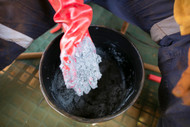If you’ve done everything to fight allergies with air purifiers, cleaning routines, and even cutting back on cuddles with your pets, but still your symptoms won't quit. It’s time to look down. Yes, your floors could be the hidden source of your sneezing. Seamless flooring offers a cleaner, smarter way to breathe easier at home without lifting a finger every day.
Seasonal allergies or pet dander are common in people. While air purifiers and frequent cleaning have become common strategies, flooring seems to be the solution. From trapped dust to hidden mold spores, traditional flooring types can make your allergies more serious. That is why homeowners are looking at seamless flooring as a game-changing solution for allergy relief.
How Flooring Impacts Indoor Air Quality
Carpets, grout lines and textured surfaces may feel cozy or look stylish. But they can trap dust mites, pollen, pet dander, mold spores and even bacteria and germs.
Over time, these allergens become embedded in spot fibres or between tiles with regular vacuuming or mopping. As people walk across the surface, these particles get stirred into the air, worsening indoor air quality and triggering respiratory issues.
In contrast to this, seamless floors are a perfect hypoallergenic alternative that actively works to improve the air you breathe.
What Makes Seamless Floors Allergy-Friendly?
Three major factors make the seamless floors allergy-free. These factors are as follows:
1: No Gaps or Grout Lines
Traditional tile floors have grout that collects dirt and allergens. Wood planks and laminate often have tiny gaps that can trap dust. Seamless floors are poured and rolled directly on the surface, creating a continuous gap-free finish. This provides a perfect finished floor.
2: Non-Porous Surface
A non-porous surface means liquid, dust, and bacteria can’t seep into the material. This is especially important for pet owners or families with young children, where spills and accidents are common. Cleanup is quick, and there is no lingering moisture to invite mold or mildew.
3: Easy to Clean
With seamless flooring, there’s no need for harsh chemicals, abrasive scrubbing or deep cleaning machines. A simple mop and a mild detergent are often all you need to maintain a hygienic surface. Less cleaning effort means less exposure to potential irritants in cleaning products, too.
A Good Option for Pet Owners
Pets bring joy. But they also bring asthma and allergies due to their fur and occasional mess. Carpets can trap this dirt, and even regular vacuuming can’t remove these pollutants. Seamless floors make it easier to keep up with the shedding and accidents, creating a more allergy-friendly space for both humans and animals.
Another benefit of having seamless floors is that these floors are scratch-resistant and odour-neutral. This makes them a practical long-term choice for pet-friendly homes.
Way Forward
If you are striving for an allergy-free home, flooring is the most important thing you can consider. Flooring should be one of your first considerations, and among this, seamless flooring is the perfect choice.
Seamless flooring creates a cleaner, healthier living environment by reducing trapped allergens, simplifying cleaning and resisting moisture build-up. So, whether you are suffering from seasonal allergies, asthma or tackling moisture trapped in the floor, seamless flooring is the ideal solution to help you breathe fresh air and is easier to clean.
A healthier home starts from the ground up, and sometimes, the solution is as simple as removing the seams

